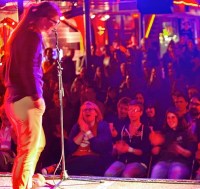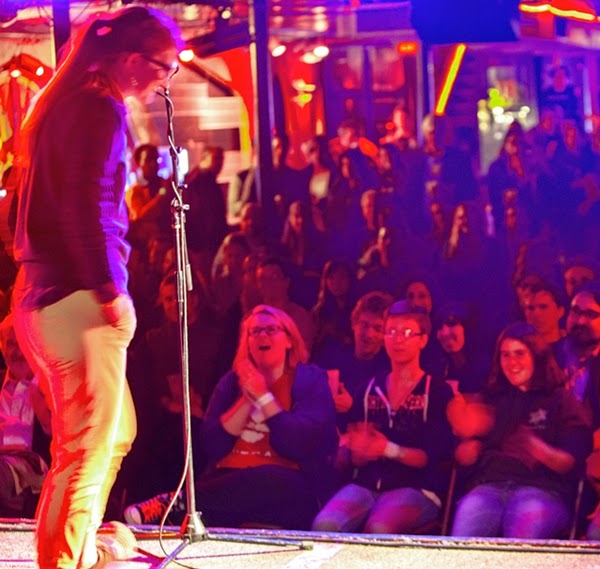Early on in our acquaintance, founding CFM Council member Peter Linett detonated a “brain grenade” with a question he has also posed on his firm’s blog: why aren’t museums more often “heartfelt, honest, gripping, funny and…deeply moving”? In today’s guest post, Peter explores the cultural trend toward passionate, personal science communication (a trend, he points out, in which museums are not leading the charge) and shares some news from a project he’s co-leading with MIT called The Evolving Culture of Science Engagement.
Ever been to a Story Collider show? Picture a bar or music club packed with young people drinking beer. Witty but authentic banter between the hosts. And a series of three or four people stepping up to the mic to tell a personal story that has some connection to science.
Some of them are scientists, maybe grad students. Some are science communicators or educators. Some aren’t in the field at all, just people who have had a memorable brush with science, broadly construed. But we’re not talking down-market TED Talks here. Not lectures, even disguised ones. The science “content” is incidental when it’s discernable at all. The point is personal, idiosyncratic human experience, and turning that experience into something communal. It’s the campfire at the mouth of the cave.
 |
| Emily Graslie at Story Collider |
The stories are what a friend might tell you about something that changed her a little or a lot — except better crafted. (Story Collider co-founder and co-host Ben Lillie comes from theater, though he also comes from theoretical physics). The storytellers say “I” or “my girlfriend and I” or “my dad, just before he died.” The stories are sweet, sad, suspenseful, adult, self-revealing, and almost always funny at some point. They’re a real person, talking to you.
Do you learn anything about science? Depends on your definition of “learning” and more importantly of “science” — which is what’s so radical about this program. It’s learning of a particularly emotional and social sort, and what you learn is a subjective rather than an objective truth: the lived experience of science, what it was like for him or her. It’s not science as a set of facts or even a way of thinking, much less a privileged way of thinking. It’s science as just another part of life.
And (not to get too meta here) because you’re enjoying it in a bar with friends instead of listening to an indie rock band or going to a movie, it’s also science as just another part of contemporary culture. That may be the biggest thing you’re “learning.”
Story Collider is hardly alone in staking this new cultural territory for science. A myriad of new programs and projects are pushing in similar directions, from Radiolab and Neil deGrasse Tyson’s StarTalk Radio to online comics like xkcd and Sci-ence and uncategorizable books by Janna Levin and the I Fucking Love Science page on Facebook and Nerd Nite and science standup comedy and a wave of musical and artistic creativity (A Capella Science or the cosmological lyrics of GZA or the biological lyrics of Bjork), among many others.
All of them break the unwritten rules of 20th century science communication and informal science education, and collectively they’re reshaping the landscape in which adults encounter science.
To get a handle on what’s happening, several colleagues and I invited some of the most creative, game-changing practitioners in the US and UK to come to MIT last fall for a two-day conversation, along with a few researchers and funders working at the same edges. We talked about how they’re using humor, story, emotion, informality, personality, social participation, artistic expression, and other contemporary sensibilities to “mainstream” science in popular culture and help new audiences connect to it. (You can read our new report here.) At the meeting were “names” and faces and voices you’d recognize — people like Tyson, Levin, GZA, Radiolab co-host Robert Krulwich, NOVA host and tech columnist David Pogue, IFLS founder Elise Andrew, physicist and author Brian Greene — along with many you wouldn’t: a new generation of bloggers and journalists, YouTubers, podcasters, festival and event organizers, citizen science pioneers, comic artists, and a guy who teaches standup to scientists.
Oh, and a few museum people.
But only a few. Because let’s face it: science centers, natural history museums and the like have not been a hotbed of the kind of culturally innovative science engagement that we’re talking about. Some have hosted Nerd Nite events and science cafés. One hired a science comedian. Another brought rising YouTube star Emily Graslie on board. But embracing is not the same as incubating. And since culture is one big ecosystem, all the creative energy we’re seeing in the broader world of science engagement is making a museum visit, by comparison, feel increasingly didactic, generic, predictable, and out of step.
My museum friends often respond with the perfectly valid point that informal science institutions are usually for families and kids, whereas the experiences I’m talking about are mostly for adults. (What, no exhibit at your local nature center titled “I Fucking Love Science!”?) But do science museums really have to choose between ceding adult science engagement to other media and importing the occasional innovative practice or practitioner from outside while continuing to offer the same core experience?
What would a science center exhibit look like if the developers and the rest of the staff saw their jobs the way Story Collider’s Lillie or physicist-novelist Levin do? What if we really challenged our own assumptions about what a story is (hint: it’s not just a narrative) or thought about how laughter helps create the conditions for interest and identification? What if we stopped trying to expand the definition of “learning” and instead tried to expand our definition of “engagement”?
I don’t know what the answers are, but I’d sure like to see us play with these questions. I talked about some of them at the ASTC conference this week on a panel with Karyn Traphagen of ScienceOnline and the aforementioned science comedian and museum professional, Brian Malow.
Do let me know what you think of the report from that MIT gathering, which was the inaugural project of my new nonprofit, Culture Kettle.
Elizabeth Merritt













Great post Peter, sorry I missed you at ASTC!
Two things that still get overlooked and/or underplayed (or more pointedly,that get cut first from budgets) are: 1)interesting, trained, PAID staff who really want to interact with museum guests, and 2) Museum spaces that foster human interaction, including amongst stangers, instead of trying to optimize "throughput."
Thanks Paul, and I would have loved to talk in Raleigh. I agree about those two overlooked priorities, especially the point about staff who actually enjoy interacting with visitors and consider that a fundamental part of their job. I have to say that science center staffs include many more such people, proportionally, than, say, art museums! As for spaces that foster social/participatory interaction among visitors, it's amazing to me how long it takes to update our our built environments to match our (rapidly evolving) ideas about what a museum is for. Yet some museum professionals continue to mistake the built environment for the idea.
Thank you for this wonderful post. Have a nice day! 🙂
KC Concrete